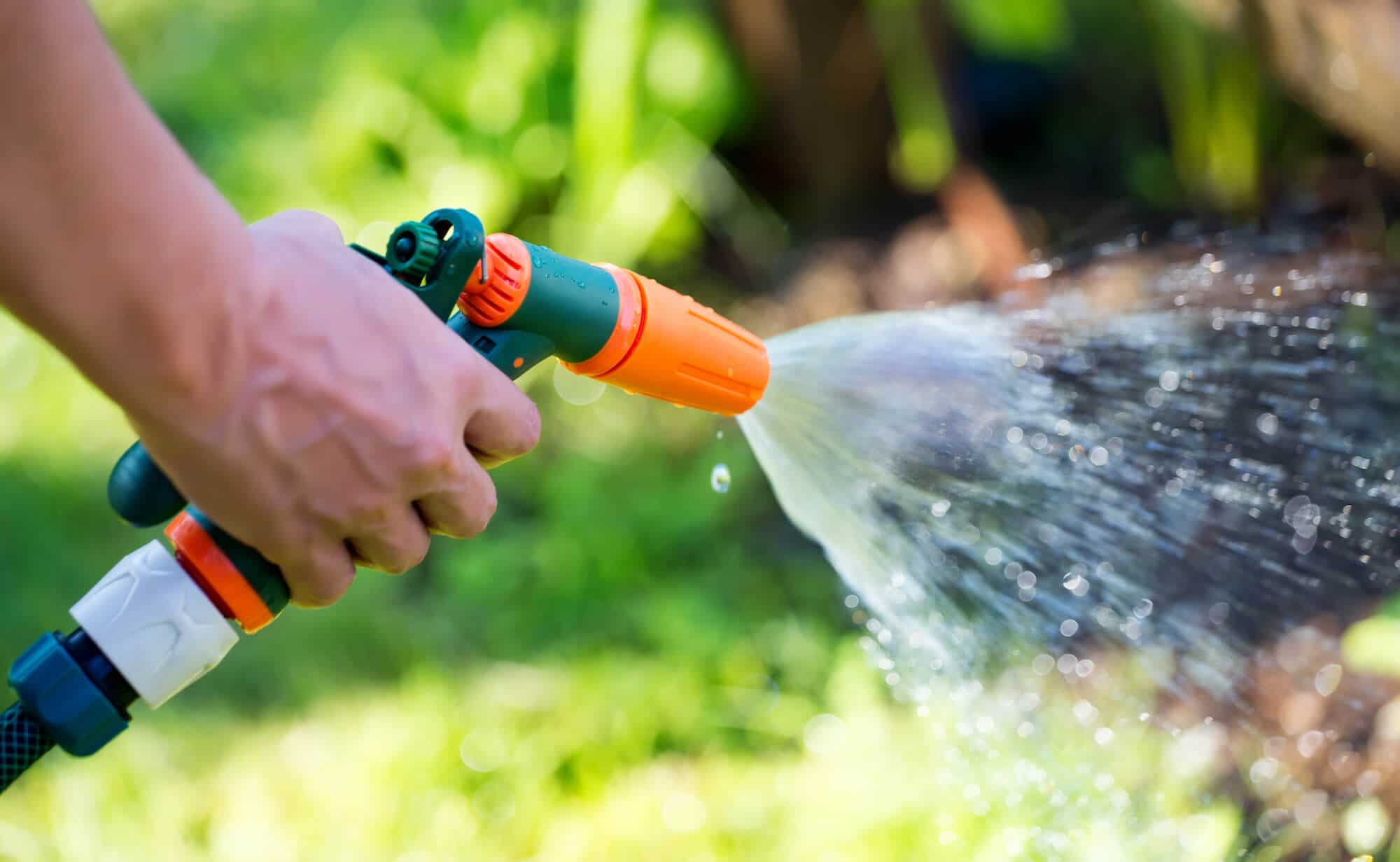Detailed Guide to Watering New Grass Seed
In every set of grass seed instructions, properly watering your lawn will top the list of the most important skills to master. Luckily, watering new grass seed follows a few basic rules that are easy to measure and not particularly time-intensive.
Growing successful new turf requires a balance between keeping the new seeds moist and not oversaturating them during the process. Too much water could cause the seeds to wash away—too little and they may never open at all.
So, how much should you water grass seeds and how long do you need to water them to ensure proper growth? We’ve constructed this step-by-step guide to determine the right amount of water for your lawn during the crucial first days after laying seed.

Why Is Water So Important to New Grass Seed?
Like all plants, water, nutrients, and the right temperatures can launch a dormant seed into its germination period. Grass seeds germinate anywhere between one to four weeks, depending on the species of grass you choose. Whichever one is right for your lawn, you’ll need a plan for keeping each seed moist throughout these early and formative days.
The Life of a Watered Grass Seed
The hard outer shell of a seed—even small grass seeds—is hard enough to keep moisture away from the center before it’s time to grow. Water will soften the hull of the seed to let in light and nutrients, indicating that germination should begin. Eventually, the embryo will absorb the water, expand, and burst free from its shell.
Timing Germination on Your Turf
Even if you apply grass seeds evenly, the water will reach each one at different times based on if something like soil or grass is blocking its flow. This is one reason why it is so important to keep your soil moist in these first few days after spreading the seed. The grass seed needs this water so it can eventually enter your soil and begin to take root.
Quick Tips for Watering Your Grass
When we say “water your lawn,” what does that actually mean? Sprinkler systems and using a hose to manually soak your lawn will differ based on water pressure and the size of your yard.
It’s up to you to determine how much water comes from your hose or sprinkler system to reach the intended amount throughout the whole space. You can test this by laying out empty cans or buckets around your lawn and measure how it takes to accumulate one inch of water.
In most cases, it’s best to break up waterings to achieve this ideal one inch by watering for shorter periods—usually around 15 minutes at a time—three times a week depending on the precipitation.
Check how much water has soaked into your soil by pressing a screwdriver into the ground and waiting for the pressure of the dry earth. The screwdriver should easily sink into the earth between one to six inches depending on the watering stage.
New Grass Seed Water Schedule
But what about new grass seed? How much water will ensure that these seeds will stay hydrated enough to flourish but not wash away or push too deeply into the ground? Here are some things to know about each stage of the process.
Before Planting: Prepping the Soil
In the early stages of planting new grass seed, you’ll want to make sure that your ground is aerated and healthy enough to support the new grass. In some cases, this may require core aeration, dethatching, or balancing the pH of your soil.
Once your soil is in good shape, your weeds are removed, and any other major issues like pests and fungus are addressed, you’re ready to start the seed spreading process.
How Much to Water Before Planting
In the several days leading up to laying your new grass seed, soak the ground to at least six to eight inches below the surface. You can use the screwdriver test we mentioned above to check the moisture of the earth. Be sure to check several areas throughout your lawn to see if the water has distributed evenly.
Complete your last major soaking the day before you lay new seed to allow the water to sink into the earth. You can moisten the earth right before planting, but the ground shouldn’t be soaking wet at this point.
Just before planting, make sure that there aren’t puddles of water pooling in any areas and that the ground is not spongy to the touch.
Immediately After Planting
Just after you spread the seed across your lawn, water consistently for 10-15 minutes with a light yet consistent flow. Keep the water light—similar to a sprinkling of rain—to protect against the seeds from washing away.
This initial soaking, however, is one of the most critical chances to soak your seeds and start the growing process. At this point, the water moisture should only go about three to four inches below the ground.
Wait until the next day to water unless the temperature is particularly hot and dry. Otherwise, let your grass rest until the next day.
Days 2-7
Germination is most active during these early days, so it is important to ensure your seeds do not dry out during this time. Water to the one-to-two-inch mark below the ground once or twice a day depending on rain.
Once you start to see the grass poke above the early, you are safe to cut back on watering to once a day for 10-15 minutes each time.
Weeks After Planting
Once your grass is long enough to mow for the first time, you can confidently get back into your usual watering schedule of one to one-and-a-half inches of water a week.
Especially in the hotter months, stick to watering your lawn in the morning hours before the sun is at its peak. This allows the excess water to slowly evaporate during the day to avoid fungus, pests, and oversaturation of your soil.
How Long Will it Take Grass Seeds to Grow?
Not all grass seeds germinate at the same speed—and not all seeds are right for every lawn. Choosing a seed will have a lot to do with your local climate, particularly if you live in a warm or cool-season grass zone.
Grass seeds take anywhere from five to 21 days to fully germinate—so you may need to alter your watering schedule based on when your seeds open and the sprout appears above the soil.
Warm-season grass seeds take a bit longer to germinate and you may need a bit more water to keep your ground moist to the desired number of inches below the surface.
Cool-season grasses should appear within the first week after planting. However, since some seed blends contain both varieties, be sure to read the seed instructions to determine the best watering schedule for you.
Threats of Overwatering Your Lawn
Most importantly, do not overwater your lawn if you want to speed up the growing process.
Watering your lawn improperly, especially in these early stages of grass seed growth can affect several lawn care issues, including:
- Weed growth
- Pest populations
- Fungus and lawn disease
- Thatch overgrowth
Water should always be able to reach the roots of your grass. Just watering enough to hydrate the grass leaves will not allow the roots to thrive, eventually killing the entire plant. However, too much water will suffocate the roots and keep oxygen from reaching beneath the soil.
Additionally, things that lead to poor lawn hydration are also encouraged by poor lawn hydration—leading your lawn into a vicious cycle once your schedule is off. Here are the major elements to keep an eye on to make sure your lawn is receiving the right amount of water.
Thatch
Once a year—or whenever you’re having problems with your turf—cut out a subsection of your lawn to measure the size of your lawn’s thatch. Thatch is the layer that lives in between the roots and the grass leaves. It will appear as a tangled tan layer of tangled grass clippings, dead roots, and other organic material.
When thatch remains under half an inch thick, it helps your turf maintain moisture during a dry period and protects against extreme temperature changes.
Overwatering your lawn, however, can lead to thatch overgrowth. The organisms in thatch should naturally break down on their own, but too much water can inhibit the process. When your thatch grows beyond half an inch, it can keep water from reaching the roots or hold too much moisture, leading to fungus.
Weed Growth
Weeds are hard enough to ward off without accidentally encouraging their growth. Too much water can lead to weeds like crabgrass and dandelions to flourish. However, other weeds like starthistle and knotweed do well in drought, so underwatering them can do just as much damage.
Look at the presence of weeds in your lawn as a red flag to check if your watering schedule needs to be adjusted. When planting new seeds, weeds can be particularly harmful since they take up precious root space in the soil meant for your new grass.
Fungus and Lawn Disease
One of the most obvious signs of overwatering occurs when your lawn develops a fungus. This typically presents itself as sudden yellow and brown patches of grass as the fungus spreads. In other cases, a visible film or circle of mushrooms may appear.
Since fungi require a moist atmosphere to grow, the spores may lay dormant in your turf and get enough moisture—especially in the process before overseeding. In other words, make sure that you cut down on your watering schedule as soon as your grass finishes germinating to avoid promoting these diseases.
Pests
Lastly, an imbalance of moisture is likely to encourage pests to nest and flourish in your lawn, including grubs, ticks, and mosquitoes. For example, if your soil becomes compacted and too much water gathers in one area, pests could lay eggs or nest in that area to plague your lawn.
Maintaining a Healthy Landscape
Simply adjusting your watering schedule—especially for new seeds—may not be enough to help the roots absorb the right amount of moisture. To tackle the issues above, keeping up a dependable lawn care schedule can help your turf avoid many of these common issues. For example:
- Aerate your lawn at least once a year, especially if your yard experiences high foot traffic
- Keep thick layers of leaves or snow drifts from forming on your lawn longer than several days to avoid fungus.
- Dethatch your lawn every time it grows beyond half an inch to encourage water and oxygen flow.
- Check your soil’s pH once a year to ensure it is maintaining the right level of moisture.
- Discourage weeds by decreasing your watering schedule when they begin to flourish.
TruGreen Lawn Care
Planting new grass can feel a bit like taking a gamble. In some cases, it may take several passes with new seed to make sure you get the watering and planting just right.
Working with a TruGreen specialist cuts down on the guesswork when spreading new grass seed, especially on fresh soil. With local offices spread throughout the country, our teams are highly knowledgeable in the unique needs of every region.
Speak with a TruGreen expert today to hear about our ongoing lawn care and maintenance plans as well as services to plant new lawns and manage a proper watering schedule. By offering a free consultation and estimate, you can rest assured that working with TruGreen will significantly cut down on precious time, effort, and costs.







